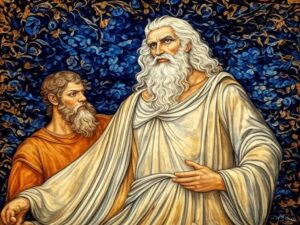Continuing in the series of book reviews. These are some of my favorite books and things that I learned the best and most things to help me in my personal growth journey. Today we are discussing the book Generations. The book “Generations” was written by William Strauss and Neil Howe. It was first published in 1991 and explores the recurring patterns of generational cycles and their impact on history and societal trends. Strauss and Howe’s generational theory identifies four archetypal cycles, each lasting approximately 80 years, and describes the characteristics and roles of different generations within these cycles. Their work has been influential in the fields of sociology, history, and generational studies.
In the intricate dance of societal evolution, the concept of generational cycles, as elucidated in the book “Generations,” sheds light on the recurrent patterns shaping our world. Presently, we find ourselves within a pivotal 80-year cycle, each phase marking a distinct era in history. As we navigate this current cycle, understanding the roles of different generations becomes paramount in comprehending the societal shifts that unfold.
The four generational archetypes identified by Strauss and Howe are the Idealist, Reactive, Civic, and Adaptive generations. Each archetype plays a unique role in shaping the trajectory of society, and the interactions between these generational types create a dynamic pattern of historical cycles.
The Current 80-Year Cycle:
- Idealist Generation (Boom):
- Characteristics: This generation is marked by a period of rising individualism, cultural upheaval, and a focus on personal expression.
- Examples: The Baby Boomers (born 1943-1960) are considered the Idealist generation, characterized by their rebellion against established norms during the 1960s and 1970s.
- Reactive Generation (Nomad):
- Characteristics: In response to the perceived excesses of the previous Idealist generation, the Reactive generation tends to be pragmatic, cautious, and focused on individual survival.
- Examples: Generation X (born 1961-1981) is considered the Reactive generation, navigating the economic challenges and cultural shifts of the late 20th century.
- Civic Generation (Hero):
- Characteristics: This generation emerges as a response to the perceived chaos and disorder of the Reactive era. Civic generations are seen as team-oriented, community-focused, and value-driven.
- Examples: The Millennials (born 1982-2004) are considered the Civic generation, marked by a sense of civic duty and a desire to make a positive impact on society.
- Adaptive Generation (Artist):
- Characteristics: Following the Civic era, the Adaptive generation tends to be flexible, pragmatic, and focused on individual achievement.
- Examples: Generation Z (born mid-1990s to early 2010s) is suggested to be the Adaptive generation, coming of age in a rapidly changing technological landscape.
Understanding these generational patterns can provide insights into the dynamics of contemporary society, helping us anticipate and navigate the challenges and opportunities that lie ahead. It’s important to approach this theory with a critical lens, recognizing that while historical patterns may repeat, each era is also shaped by unique circumstances and influences.
The Previous 80-Year Cycle: World War II and Beyond:
Before the current cycle, the generational landscape was marked by the cataclysmic events of World War II. The Greatest Generation, born in the early 1900s, bore witness to the devastation of the war and subsequently contributed to the post-war reconstruction efforts. The Silent Generation, marked by a period of conformity and cultural shift, set the stage for the social upheavals that characterized the 1960s and 1970s.
The Baby Boomers emerged as the harbingers of change during this cycle, challenging societal norms and advocating for civil rights and peace. Generation X, as the following cohort, navigated the aftermath of these transformative years, adapting to the rapid technological shifts that defined the late 20th century.
The 80-year generational phase prior to World War II encompasses a period roughly from the mid-1860s to the mid-1940s. Let’s examine the generational archetypes and major events during this time:
- Transcendental Generation (Missionary):
- Characteristics: The Transcendental generation, born in the mid-1860s to early 1880s, was marked by idealism, social activism, and a focus on moral and social issues.
- Major Events: This generation experienced the tail end of the Reconstruction era in the United States after the Civil War. They were involved in various social movements, including women’s suffrage and temperance.
- Lost Generation (Lost):
- Characteristics: The Lost Generation, born roughly between the mid-1880s and 1900, came of age during or just after World War I. They were characterized by a sense of disillusionment, cynicism, and a focus on individualism.
- Major Events: The Lost Generation witnessed the devastation of World War I and experienced the Roaring Twenties, a period of cultural and social change. The Great Depression also significantly impacted this generation.
- G.I. Generation (Hero):
- Characteristics: The G.I. generation, born in the early 1900s to the mid-1920s, was characterized by a strong sense of community, civic duty, and a focus on collective achievement.
- Major Events: This generation played a crucial role in World War II, both on the battlefield and on the home front. They also experienced the economic prosperity of the post-war period.
- Silent Generation (Artist):
- Characteristics: The Silent Generation, born from the mid-1920s to the mid-1940s, is often characterized by conformity, caution, and a focus on individual success.
- Major Events: The Silent Generation grew up during the Great Depression and came of age during the post-World War II era. They witnessed the early days of the Cold War and the beginning of the Civil Rights Movement.
Major global events during this 80-year period include the Industrial Revolution, the Progressive Era, World War I, the Roaring Twenties, the Great Depression, and World War II. These events and the generational characteristics associated with each phase provide a historical context for understanding the social, cultural, and political dynamics that shaped the world leading up to the mid-20th century.
Roles Each Generation Plays:
Each generation in these cycles plays a distinctive role in shaping the narrative of its time. The Greatest Generation exemplifies resilience and sacrifice, laying the foundation for the rebuilding of post-war societies. Baby Boomers are often credited with pushing boundaries and ushering in social and cultural revolutions. Generation X, characterized by pragmatism, adapts to the changing landscape.
Millennials and Generation Z, now taking center stage, bring digital fluency, a commitment to social justice, and a penchant for innovation. As these generations continue to influence and redefine societal norms, the cyclical nature of generational dynamics unfolds, shaping the trajectory of our collective future.
Conclusion: A Tapestry Woven Through Time
In the generational tapestry woven through time, the book “Generations” serves as a compass, guiding us through the cyclical patterns that define our history. Understanding the roles each generation plays provides insight into the dynamics of societal evolution and helps us navigate the challenges and opportunities presented in our current 80-year cycle. As we move forward, the interplay of generations continues to shape the narrative of our shared journey, contributing to the ever-unfolding story of human progress.



